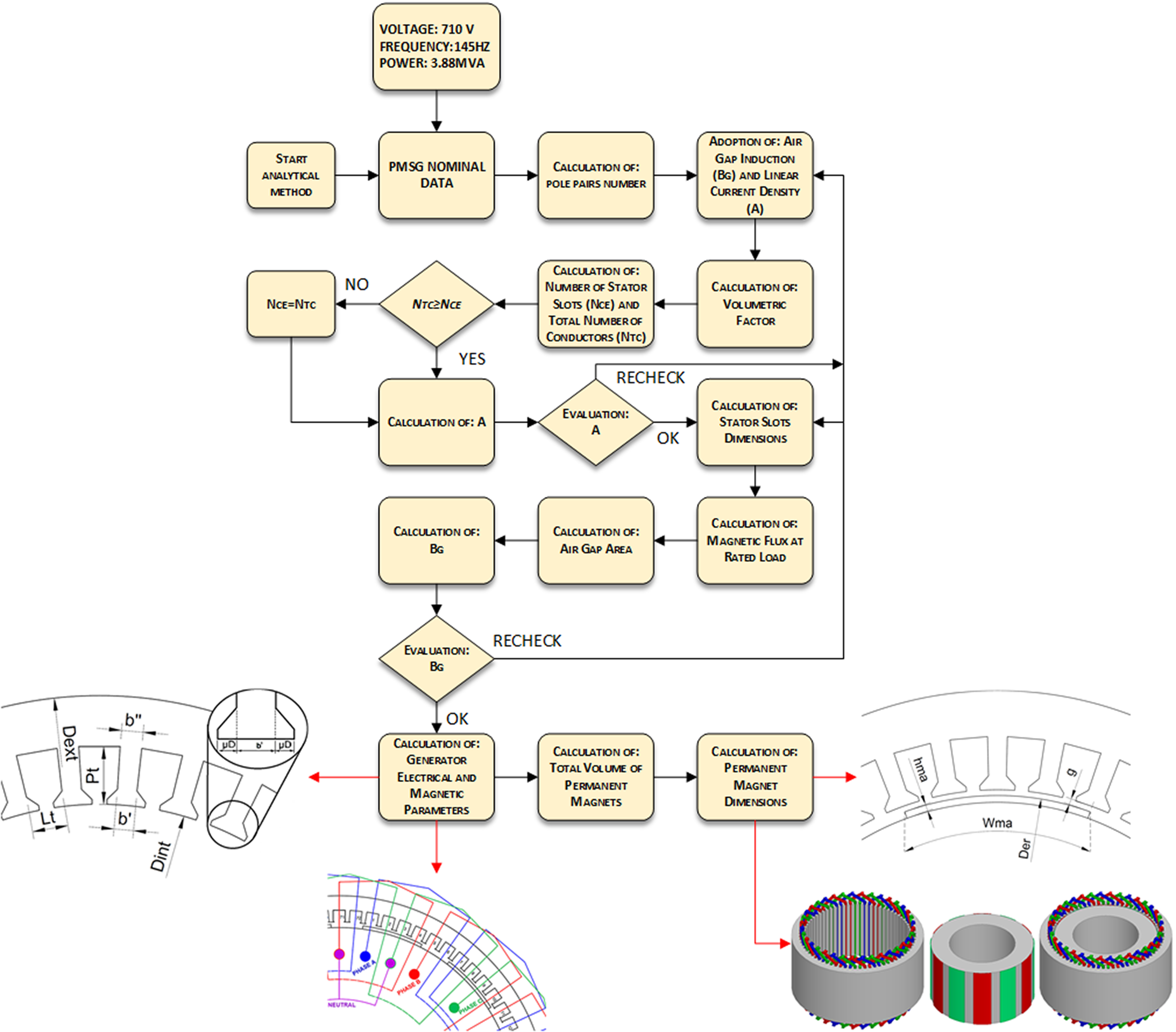Comparison of Analytical and Numerical Methods for PMSG Design Applied to D-Type Wind Generators
Keywords:
PMSG, Finite Element Analysis, Wind GeneratorsAbstract
The objective of this work is to perform a comparative study between analytical and numerical methods (implemented via 2-D and 3-D FEM software) in 3.88 MVA, 710 V, 145 Hz permanent magnet synchronous generator (PMSG) design with a focus on wind power generation, for D-Type wind turbines. For this purpose an analytical solving method is proposed using NdFeB surface permanent magnet rotor. After this step the analytical results were compared with the numerical results and showed results with average relative error margin of about 3% (2-D simulation) and average absolute error of 37.3 mT (3-D simulation). In the second part of the design, AlNiCo PM were used in the rotor, however, the analytical and numerical results showed high average error, making the previous method, used for NdFeB PM, not suitable, requiring changes in the method. It is proposed then, a readjustment of the PM volume calculation, through analytical and numerical methodology. For the development of the method the main contributions were the modification of the table of speeds and frequencies from 60 Hz to 145 Hz, the creation of an extension parameter for the tip of the stator tooth to refine the airgap flux density calculation and the analytical solution of the rotor design when using AlNiCo PM. After these changes, the results obtained with a calculated average error margin of about 4% were satisfactory. The analytical and numerical results were commented and presented at the end of this work for the validation of the methodologies for both of PM (NdFeB and AlNiCo).
Downloads
References
I. Al-Bahadly, Wind Turbines. Rijeka: IntechOpen, 2011.
S. Nanda and M. Sengupta, “Design, fabrication and analytical investigations on a permanent magnet synchronous generator,” in 2014 IEEE International Conference on Power Electronics, Drives and Energy Systems (PEDES), pp. 1–4, 2014.
J. A. Güemes, A. M. Iraolagoitia, P. Fernández, and M. P. Donsión, “Comparative study of pmsm with integer-slot and fractional-slot windings,” in The XIX International Conference on Electrical Machines -
ICEM 2010, pp. 1–6, 2010.
A. Martignoni, Alternating Current Machinery. Porto Alegre: Globo, 7 ed., 2008.
J. F. Gieras, Permanent magnet motor technology : design and applications. Polônia: CRC Press, 2010.
R. Krishnan, Permanent Magnet Synchronous and Brushless DC Motor Drives. CRC Press, Setembro, 2010.
S. Teymoori, A. Rahideh, H. Moayed-Jahromi, and M. Mardaneh, “2-d analytical magnetic field prediction for consequent-pole permanent magnet synchronous machines,” IEEE Transactions on Magnetics, vol. 52, no. 6, pp. 1–14, 2016.
D. Carpenter, S. Deleanu, C. Nguyen, M. Lau, and M. M. Rahman, “A study on determination of parameters for permanent magnet synchronous machine by comparing load tests and finite element analysis,” in 2011 24th Canadian Conference on Electrical and Computer Engineering(CCECE), pp. 000587–000592, 2011.
M. Ozeki and S. Shimomura, “Comparative study of integrated radial-axial flux rotor motor using ferrite magnet,” in 2017 20th International Conference on Electrical Machines and Systems (ICEMS), pp. 1–6, 2017.
O. Côté, A. Chebak, and J.-F. Méthot, “Design and optimization of a high torque in-wheel surface-mounted pm synchronous motor using concentrated winding,” in 2013 International Electric Machines & Drives Conference, pp. 863–870, 2013.
A. Vijay and N. P. Kumar, “Effect of demagnetization fault in spmsm using finite element analysis,” in 2021 IEEE 2nd International Conference on Smart Technologies for Power, Energy and Control (STPEC), pp. 1–6, 2021.
A. J. Sorgdrager and A. J. Grobler, “Influence of magnet size and rotor topology on the air-gap flux density of a radial flux pmsm,” in 2013 IEEE International Conference on Industrial Technology (ICIT), pp. 337–343, 2013.
Q. He and X. Bao, “Reducing cogging torque in permanent-magnet synchronous motors by auxiliary teeth method,” in 2016 IEEE 11th Conference on Industrial Electronics and Applications (ICIEA), pp. 1488–1495, 2016.
A. A. Diriye, Y. Amara, and G. Barakat, “Three-dimensional modeling of permanents magnets synchronous machines using a 3d reluctance network,” in 2018 XIII International Conference on Electrical Machines (ICEM), pp. 2304–2310, 2018.
P. Naveen, P. K. N, K. Sriganesh, T. Rajesh, and K. Sushmitha, “Stator fault analysis of permanent magnet synchronous motor using finite element method,” in 2019 4th International Conference on Recent Trends on Electronics, Information, Communication & Technology (RTEICT), pp. 655–660, 2019.
J. Faiz, Z. Valipour, M. Shokri-Kojouri, and M. A. Khan, “Design of a radial flux permanent magnet wind generator with low coercive force magnets,” in 2016 2nd International Conference on Intelligent Energy and Power Systems (IEPS), pp. 1–7, 2016.
H. Y. Lv, X. Y. Wang, J. J. Du, and L. H. Zhu, “Analytical calculation of pmsg optimization for compact er-evs application,” in 2015 IEEE International Conference on Applied Superconductivity and Electromagnetic Devices (ASEMD), pp. 551–552, 2015.
L. Dang, N. Bernard, N. Bracikowski, and G. Berthiau, “Analytical model and reluctance network for high-speed pmsm design optimization application to electric vehicles,” in 2016 XXII International Conference on Electrical Machines (ICEM), pp. 1359–1365, 2016.
Z. Guo and L. Chang, “Fem study on permanent magnet synchronous generators for small wind turbines,” pp. 641–644, 2005.
C.-Y. Hsiao, S.-N. Yeh, and J.-C. Hwang, “Design of high performance permanent-magnet synchronous wind generators,” Energies, pp. 7105–7124, 2014.
Vestas Wind Systems A/S, General Specification V112–3.0 MW 50/60Hz. Dinamarca, 2010. Documento N°.: 0011-9181 V03.
P. Bimbra, Electrical Machinery, pp. 816–865. Khanna Publishers, 2020.
G. Slemon and X. Liu, “Core losses in permanent magnet motors,” IEEE Transactions on Magnetics, vol. 26, no. 5, pp. 1653–1655, 1990.
G. Todorov and B. Stoev, “Analytical model for sizing the magnets of permanent magnet synchronous machines,” 10 2015.


